Sliding door to the wall: advantages, varieties
Interroom doors in rooms carry out two tasks: insulating and decorative. When choosing a version of interior doors, it is also important to pay attention to how much space this design will occupy in the room when open. For owners of dwellings of small dimensions, a sliding door to the wall will be an ideal door option. This model saves a lot of space in the room, and it looks individual and neat.
Equipment
The sliding door to the wall consists of the following components:
- door leaf;
- frame;
- driving mechanism;
- decorative strips;
- extras and platbands;
- fittings, it includes handles, locks and other additional small parts.
Features of structural elements
Interior doors sliding into the wall must enter and leave it without interference, otherwise, damage to both the wall and the door is inevitable. Therefore, individual structural elements of such doors have a number of features.
Let's start with the accessories. The handles must be drownable to avoid the appearance of obstacles when opening / closing the door, as for the lock, its shape also matters. An ordinary lock will not work in such a door, here you need a hook-shaped bolt. 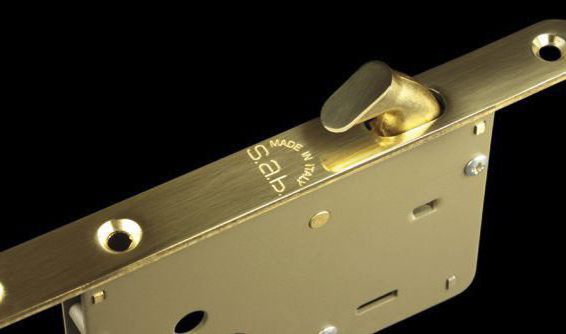
Special attention should be paid to the mechanism for moving the door, which includes:
- guide (there may be one or two guides, most often an aluminum profile is taken for their manufacture);
- roller carriages are made of a special-purpose polymer material that is particularly resistant to abrasion, bearings play the main role in the smooth rotation of the carriages, the standard number of rollers must be increased when installing a heavy door leaf (solid wood, for example).
- clamps.
And the door leaf itself is better to choose with the smallest possible weight, since an increase in its mass leads to a greater load on the door movement mechanism and it warps and reduces smoothness.
Classification
Interior doors are divided according to a number of characteristics.
Depending on the manufacturing method, there are:
- shield;
- paneled.
From the execution method:
- with glasses;
- solid canvas.
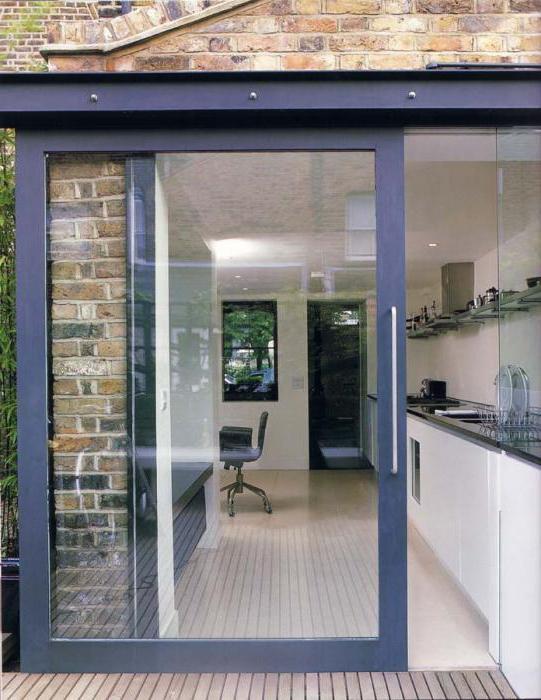
From material used:
- from solid wood;
- plastic;
- other materials.
Depending on the type of decorative coating:
- laminated;
- melamine;
- veneered.
How does a sliding door slide into a wall?
There are two ways to install such doors.
First, the sliding door moves along two guides, moves along rails that are installed on the ceiling and on the floor. More often, wardrobes are equipped with this method of installing doors. This installation option is cheaper, but not very convenient due to the lower rails, they often become a hindrance when walking. True, you can mount them deep into the floor, but then there will be difficulties in cleaning. This option cannot boast of perfect aesthetics. But the second one is fine. 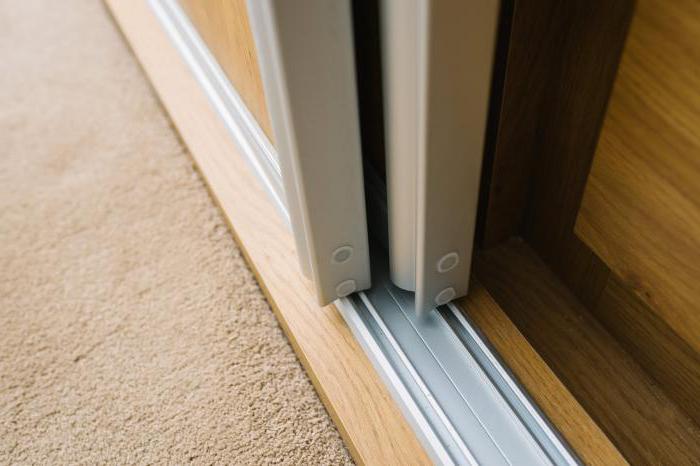
The second way is one guide, which is most often installed above the doorway and does not create barriers for a person. In addition, when the door is open, there is no separation of the floor surface, which creates the appearance of a unified space.
By type of running gear
Sliding door to the wall according to the method of movement relative to the wall is of the following types:
- A door that moves inside the door frame is limited by the size of the door frame, i.e. it can only be installed in openings of sufficient size.
- Doors moving along the wall can be made of any material and move along the rails. Their number depends on the severity of the door itself, sometimes it is necessary to mount two guides - the upper and lower, and sometimes one upper rail is enough.
This type of sliding door has a number of disadvantages:
- firstly, the door always remains in sight both in the open and in the closed position;
- secondly, the wall on which the door enters loses its functionality, you can no longer hang a picture or a bookshelf on it;
- thirdly, low sound insulation resulting from the formation of a technological gap between the door and the wall.

Cassette mount system
This method of installation makes it possible to maximize the useful area of small-sized housing, since sliding interior doors hidden in the wall do not take up space. As a result of this, furniture can be placed along the wall into which the door has entered.
To implement such an idea, it is necessary that the sliding doors to the plasterboard wall are completely hidden. To this end, a niche is equipped either during the construction of the walls of the room, or a part of an existing one is destroyed, into which a plasterboard box is subsequently mounted. The latter option requires a lot of material costs, as well as the availability of permission to change the layout, especially when the wall is load-bearing.
Sliding doors hidden in the wall are single-leaf and double-leaf.
Sliding Door Benefits
The sliding door along the wall moves smoothly and quietly along the rails. This is a mandatory characteristic, which is achieved through the use of sound-absorbing rails, and only if they are correctly installed.
There is no unpleasant opportunity to catch clothes or some objects on the door handle, as it is of a mortise type.
This type of door can easily be left half-open, because it will not be able to slam itself shut in a draft, for example. This is especially important for doors with glass elements.
Aesthetic and neat appearance - is achieved by decorating the door leaf with glass (on which drawings or mosaics can be applied), stickers or original coatings.
And the most important advantage is, of course, space saving. 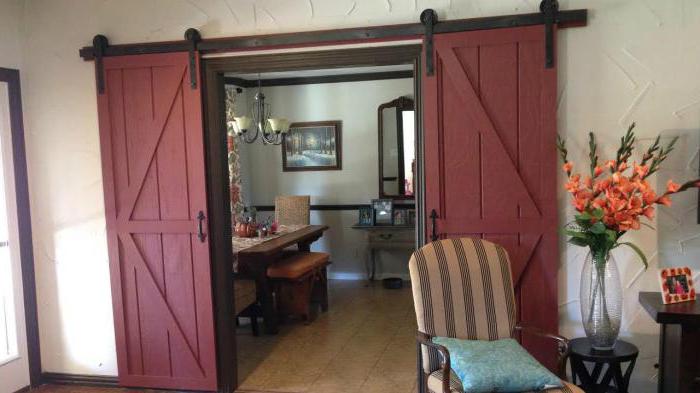
Types of materials for the pencil case
Moisture resistant plywood - in most cases used for bathrooms. Designs are characterized by low weight, compactness and ease of installation. It will not be difficult to independently install this type of pencil case, it does not require special adjustment and long engineering calculations. The cost of such a niche is small and belongs to budget options. This type of construction will be ideal for light weight doors.
Profiled steel - is sold in the form of a finished case made of profiled steel, this design is durable and reliable in operation. It plays well with heavy door panels made, for example, from solid wood. But all these positive qualities cost a lot of money, this version of the door niche is the most expensive.
A drywall pencil case is a universal and most popular option; it took this position due to the reliability and strength of its design. The plasterboard case is suitable for all types of sliding door panels. But the installation of this type of pencil case requires time and serious engineering calculations. Therefore, it is better to entrust the construction of a drywall niche to professionals. As for cash costs, here they are minimal.
General rules for mounting the finished canister
When buying a ready-made pencil case, detailed installation instructions are attached to the purchase. 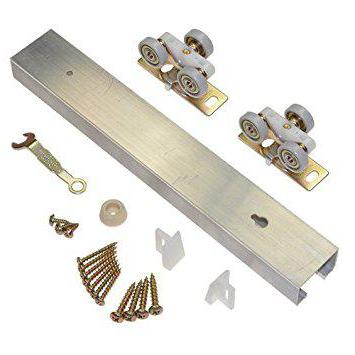
It looks something like this:
- you need to collect the pencil case itself;
- attach the door frame to the pencil case;
- attach the assembled structure to the wall opening;
- check the accuracy of the installation with a building level, and with a positive result, fix the structure with hardware;
- install the door
- close the wall with drywall.
The interior of housing, in which there are sliding doors, always looks beautiful and modern, because the variety of such door panels amazes with a stylistic range from classic to hi-tech.
 Masonry mortars for brick kilns
Masonry mortars for brick kilns Why do the windows fog up in the apartment
Why do the windows fog up in the apartment Construction and schemes of brick ovens
Construction and schemes of brick ovens How to lay paving slabs: tips and tricks
How to lay paving slabs: tips and tricks How to drill bathroom tiles
How to drill bathroom tiles Monolithic slab on coarse soil
Monolithic slab on coarse soil Which electric heater is economical
Which electric heater is economical